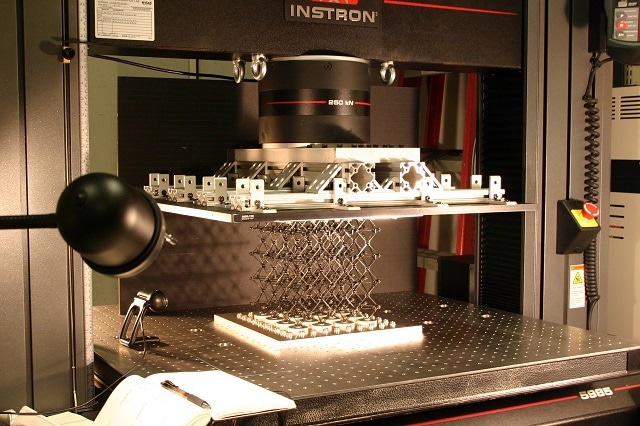All that time spent playing with plastic bricks as a kid may finally be paying off, as tiny composite blocks developed by MIT have been used to create a lightweight structure and could lead to much more design freedom in composite manufacturing.

Assemblies of the cellular composite material are seen from different perspectives, showing the repeating "cuboct" lattice structure, made from many identical flat cross-shaped pieces. Photo courtesy of Kenneth Cheung.
Likened to chainmail armor, the identical composite blocks can be easily snapped together and taken apart, and are based on a unique geometry developed by postdoc Kenneth Cheung and Neil Gershenfeld, director of MIT’s Center for Bits and Atoms.
Composites are today used in a myriad of applications, from jet planes to golf clubs. Composites exhibit excellent strength, have good stiffness-weight ratios, are very durable, and can be formed into complex shapes relatively easily.
One of the drawbacks of current composite component manufacturing is that components need to be formed as a continuous unit. This is not such an issue for smaller structures, but for constructing aircraft wings, huge facilities are required. The new composite block construction technique would do away with this complication.

In the lab, a sample of the cellular composite material is prepared for testing of its strength properties. Photo courtesy of Kenneth Cheung.
The potential benefits of the new approach are varied and many. Some of the primary benefits are highlighted below.
Importantly, the new parts can be mass-produced and it is hoped that the manufacturing possibilities are very diverse. Here are just a few examples of structures that could be constructed using the blocks:
- Airplane wings and fuselages
- Spacecraft
- Dikes
- Levees
- Bridges
- Rockets
The ease with which structures could be assembled and dismantled also increases dramatically,
making repairing damage to structures, or enhancing them, a lot simpler. Further to this, structures made in this way will only fail incrementally, potentially making this construction method more reliable when compared to conventional composites, as these often fail abruptly and at a large scale.
It can also be seen as a rather environmentally friendly endeavor as if a structure created from the blocks becomes obsolete, the constituent blocks can simply be recycled into a different product.
Lastly, the light-weighting of vehicles could be improved as the new technique allows larger loads to be carried by less material. This also feeds back into the ‘green’ benefits, as this light weight may reduce fuel use.
So it seems that this seemingly simple method of creating structures could have many benefits and applications in many different areas.
Original Source: http://web.mit.edu/press/
Disclaimer: The views expressed here are those of the author expressed in their private capacity and do not necessarily represent the views of AZoM.com Limited T/A AZoNetwork the owner and operator of this website. This disclaimer forms part of the Terms and conditions of use of this website.